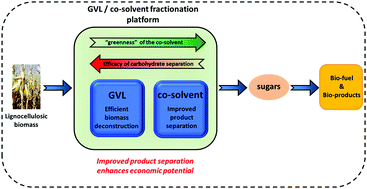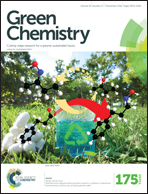An engineered solvent system for sugar production from lignocellulosic biomass using biomass derived γ-valerolactone
Abstract
γ-Valerolactone (GVL) is a biomass-derived solvent which completely solubilizes all fractions of lignocellulosic biomass, leading to the recovery of polysaccharides (cellulose and hemicellulose) as soluble carbohydrates at high yields (>70%) without the use of expensive reagents, like enzymes and ionic liquids. Biological upgrading of carbohydrates to biofuels or bio-based chemicals requires that the carbohydrates are separated from GVL. We demonstrate that an engineered solvent system consisting of GVL, water and an organic co-solvent is mono-phasic at the temperatures used for biomass fractionation (e.g., 160 °C) and is bi-phasic at lower temperatures (e.g., room temperature). The advantage of using this engineered solvent system is that the carbohydrates are spontaneously separated from organic solvent components into an aqueous hydrolysate stream, thereby avoiding the need for expensive and potentially hazardous separation processes, such as operation at elevated pressures required for separation using liquid CO2. We also show that the organic co-solvent can be selected from an array of organic components, leading to a trade-off between the efficacy of carbohydrate separation and the ‘greenness’ of the solvent. We show further that toluene is a promising co-solvent component, and techno-economic analyses of the process, wherein toluene is used as a co-solvent, lead to a minimum selling price of ethanol of $3.10 per gallon of gasoline equivalent.


 Please wait while we load your content...
Please wait while we load your content...